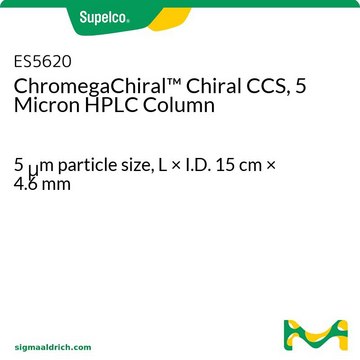912689
Enantioprobe (S)-5
≥95%
Synonym(s):
(S)-N-(1-Benzylpyrrolidin-3-yl)-3-(3-(but-3-yn-1-yl)-3H-diazirin-3-yl)-N-methylpropanamide, Fully functionalized enantioprobe, Ligandability probe
About This Item
assay
≥95%
form
liquid
storage temp.
−20°C
1 of 4
This Item | ES5624 | ES5617 | ES5615 |
|---|---|---|---|
| matrix active group amylose, carbamate phase | matrix active group amylose, carbamate phase | matrix active group amylose, carbamate phase | matrix active group amylose, carbamate phase |
| particle size 5 μm | particle size 5 μm | particle size 5 μm | particle size 5 μm |
| separation technique chiral, supercritical fluid (SFC) | separation technique chiral, supercritical fluid (SFC) | separation technique chiral, supercritical fluid (SFC) | separation technique chiral, supercritical fluid (SFC) |
| pore size 1000 Å pore size | pore size 1000 Å pore size | pore size 1000 Å pore size | pore size 1000 Å pore size |
| product line ChromegaChiral™ | product line ChromegaChiral™ | product line ChromegaChiral™ | product line ChromegaChiral™ |
Application
Together, the 16 enantioprobes support ligandability studies in living cells, a significant method for development of chemical probes and lead discovery efforts to find binders for traditionally ″undruggable″ protein targets. This strategy is also compatible with multiplexing for higher throughput.
- Fluorophore-conjugated azide tags for SDS-PAGE in-gel profiling: 910147, 760757, 760765, 777315, 777323
- Azide-biotin tags for enrichment: 901765, 914134, 914460, 762024, 900912, 900891, QBD10825)
- Azide capture solid supports: 900957, 742627
- Streptavidin for biotin enrichment: S6940, E5529, E2513, 69203, 16-126, S1638
- Mass spectrometry and Multiplexing
related product
Storage Class
11 - Combustible Solids
wgk_germany
WGK 3
flash_point_f
Not applicable
flash_point_c
Not applicable
Choose from one of the most recent versions:
Certificates of Analysis (COA)
Sorry, we don't have COAs for this product available online at this time.
If you need assistance, please contact Customer Support.
Already Own This Product?
Find documentation for the products that you have recently purchased in the Document Library.
Articles
Ligandability describes the propensity of a protein target to bind a small molecule with high affinity. It is a precursor to evaluating druggability, which requires more advanced translational pharmacological effects and drug-like properties in vivo.
Our team of scientists has experience in all areas of research including Life Science, Material Science, Chemical Synthesis, Chromatography, Analytical and many others.
Contact Technical Service
